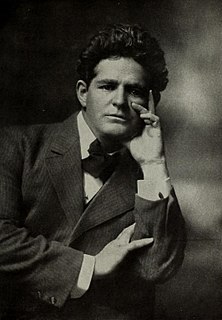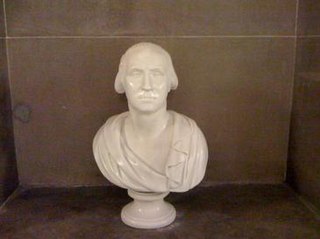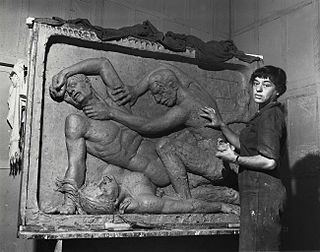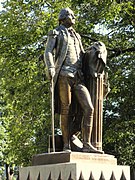
Jean-Antoine Houdon was a French neoclassical sculptor.

George Grey Barnard, often written George Gray Barnard, was an American sculptor who trained in Paris. He is especially noted for his heroic sized Struggle of the Two Natures in Man at the Metropolitan Museum of Art, his twin sculpture groups at the Pennsylvania State Capitol, and his Lincoln statue in Cincinnati, Ohio. His major works are largely symbolical in character. His personal collection of medieval architectural fragments became a core part of The Cloisters in New York City.

Alexander Stirling Calder was an American sculptor and teacher. He was the son of sculptor Alexander Milne Calder and the father of sculptor Alexander (Sandy) Calder. His best-known works are George Washington as President on the Washington Square Arch in New York City, the Swann Memorial Fountain in Philadelphia, and the Leif Eriksson Memorial in Reykjavík, Iceland.

William Ordway Partridge was an American sculptor, teacher and author. His sculptures can be found in New York City, Washington, D.C., Chicago and elsewhere.

The Gorham Manufacturing Company is one of the largest American manufacturers of sterling and silverplate and a foundry for bronze sculpture.

Henry Merwin Shrady was an American sculptor, best known for the Ulysses S. Grant Memorial on the west front of the United States Capitol in Washington, D.C.

The United States Capitol rotunda is the tall central rotunda of the United States Capitol in Washington, D.C. It has been described as the Capitol's "symbolic and physical heart". Built between 1818 and 1824, the rotunda is located below the Capitol dome, which was built between 1857 and 1866.

Harriet Whitney Frishmuth was an American sculptor known for her works in bronze.

George Washington, also known as Enthroned Washington, is a large marble sculpture by Horatio Greenough commissioned by the United States Congress on July 14, 1832 for the centennial of U.S. President George Washington's birth on February 22, 1732. Completed in 1840, the statue was soon exhibited in the Rotunda of the United States Capitol and then moved to the Capitol's east lawn in 1843. Since 1964 it has been in the National Museum of American History.

The Bartholdi Fountain is a monumental public fountain, designed by Frédéric Auguste Bartholdi, who later created the Statue of Liberty. The fountain was originally made for the 1876 Centennial Exposition in Philadelphia, Pennsylvania, and is now located at the corner of Independence Avenue and First Street, SW, in the United States Botanic Garden, on the grounds of the United States Capitol, in Washington D.C..

William James Hubard (1807–1862) was British-born artist who worked in England and the United States in the 19th century. He specialized in silhouette and painted portraits.

George Washington is a public artwork that is a limited edition copy of an original work by French neoclassical sculptor Jean Antoine Houdon that is on display inside the Indiana Statehouse, which is located in Indianapolis, Indiana, United States. The artwork was cast a solid piece of plaster that has been painted white.

George Washington is a public artwork by American sculptor Donald De Lue, located on the grounds of the Indiana Statehouse, in Indianapolis, Indiana, United States. The bronze statue of George Washington that occupies the Indiana Statehouse south lawn is one of several copies of a 1959 original wax cast at the Modern Art Foundry in Long Island, New York.

The statue of John Aaron Rawlins, a United States Army general who served during the Civil War and later as Secretary of War, is a focal point of Rawlins Park, a small public park in Washington, D.C.'s Foggy Bottom neighborhood. It was installed in 1874, but relocated several times between 1880 and 1931. The statue was sculpted by French-American artist Joseph A. Bailly, whose best known work is the statue of George Washington in front of Independence Hall in Philadelphia.

George Washington is a marble bust portrait of George Washington, done in the style of a Roman emperor, by the Italian sculptor Giuseppe Ceracchi. It was created as part of a campaign by Ceracchi to build a larger monument to Washington. The bust was thought by many to be one of the most lifelike. It was later used as a model of Washington for works by other sculptors and engravers.

Hélène Sardeau was an American sculptor, born in Antwerp, Belgium, who moved with her family to the United States when she was about 14 years old.

Pedimental sculptures in the United States are sculptures within the frame of a pediment on the exterior of a building. Pedimental sculptures pose special challenges to sculptors: the triangular composition limits the choices for figures or ornament at the ends, and the sculpture must be designed to be viewed both from below and from a distance.






















